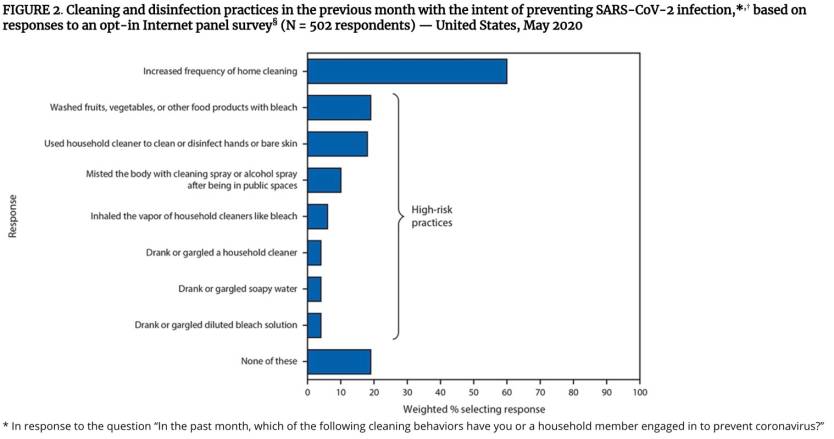- Coronavirus disinfectants and cleaners should not be used on or in the human body in an attempt to prevent COVID-19.
- A new CDC study says that 39% of respondents engaged in at least one high-risk practice with such chemicals, which includes drinking or gargling with soapy water or diluted bleach solutions.
- The research suggests a need for more public messaging regarding safe and effective cleaning and disinfection practices, with a focus on gaps in knowledge that can lead to harmful behavior.
Thanks to Trump’s bizarre ramblings, one of the coronavirus myths that circulated in the early days of the pandemic suggested that the novel disease can be cured with bleach. By mid-April, the FDA and FTC had to issue formal warnings to businesses selling coronavirus treatments that a variation of bleach won’t cure COVID-19. Several weeks after that, the maker of Lysol issued an official statement warning people that chemical products that can be used to neutralize the virus on surfaces aren’t supposed to be ingested. The official comment came in response to a remark Trump made on TV the same week when he asked his officials whether there would be a way to inject disinfectants into the human body to kill the virus as efficiently as they do on surfaces. Trump later lied and said those remarks were meant to be a joke, just as some local officials warned people that disinfectants shouldn’t be administered via injection or ingested in an attempt to prevent or cure COVID-19.
It turns out some people are willing to do precisely that, according to a new study from the Centers for Disease Control and Prevention (CDC). Researches conducted a survey of 502 Americans in May inquiring about knowledge and practices regarding household cleaning and disinfection. 39% of respondents admitted to engaging in some form of high-risk practice, which included gargling with bleach.
The CDC says it conducted the research because “a recent report described a sharp increase in calls to poison centers related to exposures to cleaners and disinfectants since the onset of the coronavirus disease 2019 (COVID-19) pandemic,” and data is limited. The results were troubling, as the CDC identified various use cases of chemicals that can lead to unwanted side effects being used improperly, all in an effort to prevent an infection.

Some respondents said they’ve been washing fruits and vegetables with bleach and that they’ve been misting their bodies with disinfectant sprays. They’ve also said they have inhaled vapors from cleaners or disinfectants or drank and gargled with soapy water, diluted bleach solutions, and other disinfectant solutions:
Thirty-nine percent reported intentionally engaging in at least one high-risk practice not recommended by CDC for prevention of SARS-CoV-2 transmission, including application of bleach to food items (e.g., fruits and vegetables) (19%); use of household cleaning and disinfectant products on hands or skin (18%); misting the body with a cleaning or disinfectant spray (10%); inhalation of vapors from household cleaners or disinfectants (6%); and drinking or gargling diluted bleach solutions, soapy water, and other cleaning and disinfectant solutions (4% each).
The report also notes that 25% of respondents reported at least one adverse health effect during the previous month that they believe was a result of exposure to those chemicals:
One quarter (25%) of respondents reported at least one adverse health effect during the previous month that they believed had resulted from using cleaners or disinfectants, including nose or sinus irritation (11%); skin irritation (8%); eye irritation (8%); dizziness, lightheadedness, or headache (8%); upset stomach or nausea (6%); or breathing problems (6%). Respondents who reported engaging in at least one high-risk practice more frequently reported an adverse health effect than did those who did not report engaging in such practices (39% versus 16%).
In light of these findings, the CDC says there’s a need for public messaging regarding “regarding safe and effective cleaning and disinfection practices aimed at preventing SARS-CoV-2 transmission in households”.
“COVID-19 prevention messages should continue to emphasize evidence-based, safe practices such as frequent hand hygiene and frequent cleaning and disinfection of high-touch surfaces,” the CDC wrote. While the study also showed that people know how to use some of the targeted chemicals and store them safely, there’s room for improvement. “Prevention messages should highlight identified gaps in knowledge,” the study notes.
“These messages about cleaning and disinfection practices for COVID-19 prevention can be coordinated and disseminated through trusted sources of information such as national, state, and local public health agencies and medical providers,” the CDC says.








